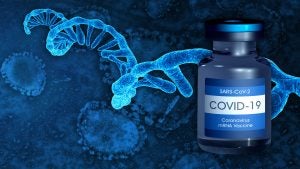In record time we’ve got a couple of COVID vaccines — vaccines like no others before them.
Vaccines have always been made with proteins from a dead or incapacitated infectious agent. Pfizer’s and Moderna’s vaccines use a laboratory-made piece of genetic material, a synthetic RNA molecule that mimics instructions for a COVID protein. What is RNA (ribonucleic acid) and how does it work? RNA is a long chain made from four nucleic acid base molecules, same as DNA (deoxyribonucleic acid), except RNA substitutes uracil for thymine. RNA is also (usually) single stranded instead of double stranded. DNA is the storage molecule for heredity data and resides inside the cell nucleus and cell organelles, such as mitochondria or chloroplasts.
RNA is made as needed and resides in the cytoplasm, the liquid portion of the cell, among all the proteins, enzymes, and raw materials needed to carry out the cells function. It exists in many forms and has many different functions. The RNA most frequently talked about in the press is mRNA, shorthand for messenger RNA. Its job is to decipher formulas for proteins and other molecules from the DNA instruction book and carry the instructions to a ribosome, another very large RNA molecule that assembles the proteins necessary to keep living things running smoothly. Once its job is done, mRNA is disassembled by enzymes — called nucleases — and the parts reused.
RNA molecules of all sorts are constantly being made and disassembled as the cell’s work goes on.

Back to Pfizer’s and Moderna’s vaccines. Looking at the genetic code of the virus, researchers were able to determine the portion that coded for the mRNA of the spike protein the virus uses to attach to and enter a cell. They then duplicated those mRNA instructions and encased them in small fat vesicles. Injected into a person’s arm, the vesicles enter cells and disperse their load of mRNA. The mRNA finds a ribosome and assembly of the spike protein begins. The spike protein exits the cell and attaches to the cell wall. The immune system recognizes it is a rogue protein and fires up an immune response that produces antibodies; antibodies that will attack the virus if a person comes in contact with it.
Wait! This column is supposed to be about agricultural stuff. So why talk about human vaccines? The reason: Agrobiotech companies are working on vaccines for plants (yes) and pesticides based on RNA molecules.
How can you vaccinate a plant? Scientists use another type of RNA called interference RNA (RNAi). RNAi with a code sequence that matches an mRNA on its way to a ribosome can intercept and bind to the mRNA, disabling it and preventing production of a protein essential for an organism’s survival. The trick is to find a protein that is essential to the growth and maintenance of a pest insect or disease, but not essential to non-target plants, animals, or insects. Once found, the DNA gene that produces the mRNA for that protein is determined. A matching synthetic RNAi can then be sprayed onto the plant and taken up by the plant and, if present, a fungus or insect attacking the plant. Within a week or so, the RNAi is dismantled by plant enzymes and disappears from the environment. Meanwhile, the pest has been denied vital nourishment and dies.
More permanent protection for the plant can be accomplished by genetically engineering the plant to produce the required RNAi. Monsanto did that with a corn plant, giving it the ability to attack the corn rootworm that feeds on the roots. They gained registration for this trait in 2017. This type of genomic change is not considered a GMO by regulators because no foreign DNA is introduced.
RNAi and mRNA molecules are being assembled and disassembled at all times in plant and animal cells. It’s a normal function of living tissue. Genes must be turned off or on depending on what kind of tissue they function in. RNAi silencing is one of the ways genes are turned off. For example, RNAi gene silencing was used by Okanagan Specialty Fruits to turn off production of the protein that causes apples to turn brown when cut (Artic Apples). The same technique was used by Simplot to reduce browning in cut or bruised potatoes (Innate Potatoes). You could say these plants have been vaccinated against browning.
Because RNAi pesticides are very specific as to the protein or other essential molecule they target, they are very safe to non-target species, be they humans, animals, plants or insects. But, as expected, RNAi pesticides do not escape criticism from environmental groups. Eating them, they claim without evidence, could interfere with human gene regulation. Never mind that we eat millions of natural mRNA and RNAi molecules every time we eat our vegetables. Or, they say, synthetic RNAi could affect gene regulation in non-target species, such as honeybees. Research by Bayer, Syngenta BASF, and others who are developing these pesticides suggest safety to non-target organisms, including humans, is unprecedented. RNAi is even being investigated as a means of promoting bee health by disrupting growth and maintenance of bee viruses and the varroa mite.
As with any pesticide, RNAi pesticides will undergo extensive safety tests before release. Especially those that involve altering a plant’s DNA to produce a desired RNAi that could end up in the digestive tract of humans or animals. RNAi pesticides that can be sprayed on and absorbed by a plant will be dismantled by the plant enzymes in the regular course of plant metabolic processes, and will then pose no threat to any living thing or the environment.
We are on the cusp of a new generation of pesticides that will be safe and, environmentally, a non-issue (or should be).
Jack DeWitt is a farmer-agronomist with farming experience that spans the decades since the end of horse farming to the age of GPS and precision farming. He recounts all and predicts how we can have a future world with abundant food in his book “World Food Unlimited.” A version of this article was republished from Agri-Times Northwest with permission.



